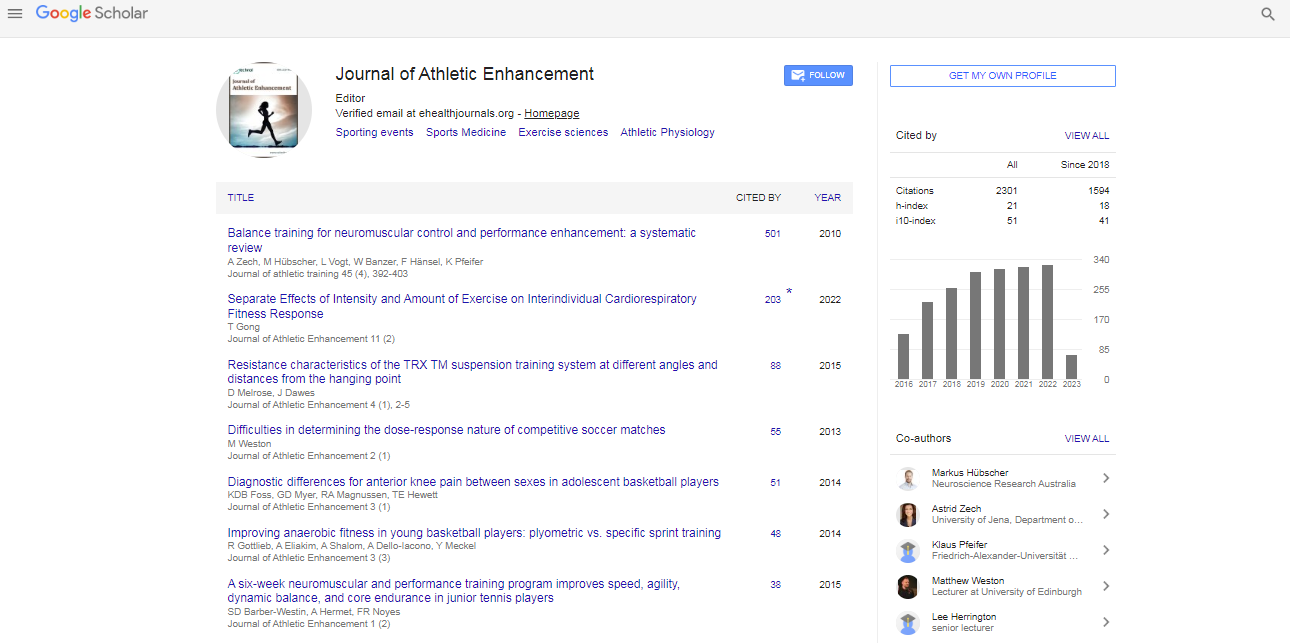Commentary, J Athl Enhanc Vol: 12 Issue: 2
An Overview on Muscle Activation and its importance in Sports
Stefan Scharen*
1Department of Sorts, University Hospital Basel, Basel, Switzerland
*Corresponding Author: Stefan Scharen
Department of Sorts, University Hospital Basel, Basel, Switzerland
E-mail: scharenst_efan@usb.ch
Received date: 06-Feb-2023, Manuscript No. JAE-23-94495;
Editor assigned date: 09-Feb-2023, PreQC No. JAE-23-94495 (PQ);
Reviewed date: 23-Feb-2023, QC No JAE-23-94495;
Revised date: 02-Mar-2023, Manuscript No. JAE-23-94495 (R);
Published date: 09-Mar-2023 DOI: 10.4172/2324-9080.100067.
Citation: Scharen S (2023) An Overview on Muscle Activation and its Importance in Sports. J Athl Enhanc 12:2.
Keywords: Eating Habits of Athletes, Exercise Science, Injury Management
Description
Muscle activation refers to the physiological process by which a muscle generates tension through the recruitment of Motor Units (MU) in response to neural input. Motor units are composed of a motor neuron and the muscle fibers it innervates. When a motor neuron fires an action potential, all the muscle fibers it innervates contract. The number of motor units recruited determines the force generated by a muscle.
Muscle activation is a complex process that involves both neural and muscular factors. The neural factors include the activation of motor neurons and the release of neurotransmitters, while the muscular factors include the number and type of muscle fibers recruited the length-tension relationship, and the metabolic state of the muscle.
The neural factors of muscle activation are initiated by the Central Nervous System (CNS) in response to a motor command. The motor command is generated in the primary motor cortex and is transmitted to the spinal cord via descending motor pathways. In the spinal cord, the motor command is translated into motor neuron activity, which is transmitted to the muscles via motor axons.
The number of motor units recruited is determined by the size principle, which states that motor units are recruited in order of their size, with the smallest recruited first and the largest recruited last. Small motor units contain slow-twitch muscle fibers, which are fatigue-resistant and produce low levels of force. Large motor units contain fast-twitch muscle fibers, which are fatigable and produce high levels of force. The recruitment of motor units follows a graded response, meaning that as the force required by a muscle increases, more motor units are recruited.
The length-tension relationship also plays a role in muscle activation. The length-tension relationship refers to the relationship between the length of a muscle fiber and the force it can generate. When a muscle fiber is at its resting length, it can generate the most force. If a muscle fiber is stretched beyond its resting length, it cannot generate as much force, and if it is shortened beyond its resting length, it cannot generate as much force either. The length-tension relationship is important because it determines the optimal length of a muscle fiber for generating force.
The metabolic state of the muscle also affects muscle activation. Muscles rely on energy sources such as Adenosine Triphosphate (ATP) and glycogen to generate force. When the muscle is fatigued, it cannot generate as much force because the energy sources have been depleted. Muscles also produce metabolic by products such as lactate during exercise, which can accumulate and impair muscle function.
Muscle activation is very important for many activities, including movement, posture, and stabilization. When a muscle is activated, it generates tension, which can cause movement at a joint. For example, when the biceps muscle is activated, it generates tension that causes the elbow joint to flex. Muscles also play a role in maintaining posture and stabilizing joints. For example, the muscles of the core help to maintain an upright posture and stabilize the spine during movements such as bending and twisting.
Muscle activation can be assessed using Electromyography (EMG), which measures the electrical activity of muscles. EMG can provide information about the timing and amplitude of muscle activation during movement, as well as the recruitment of different motor units. EMG can also be used to assess muscle function in individuals with neuromuscular disorders.

